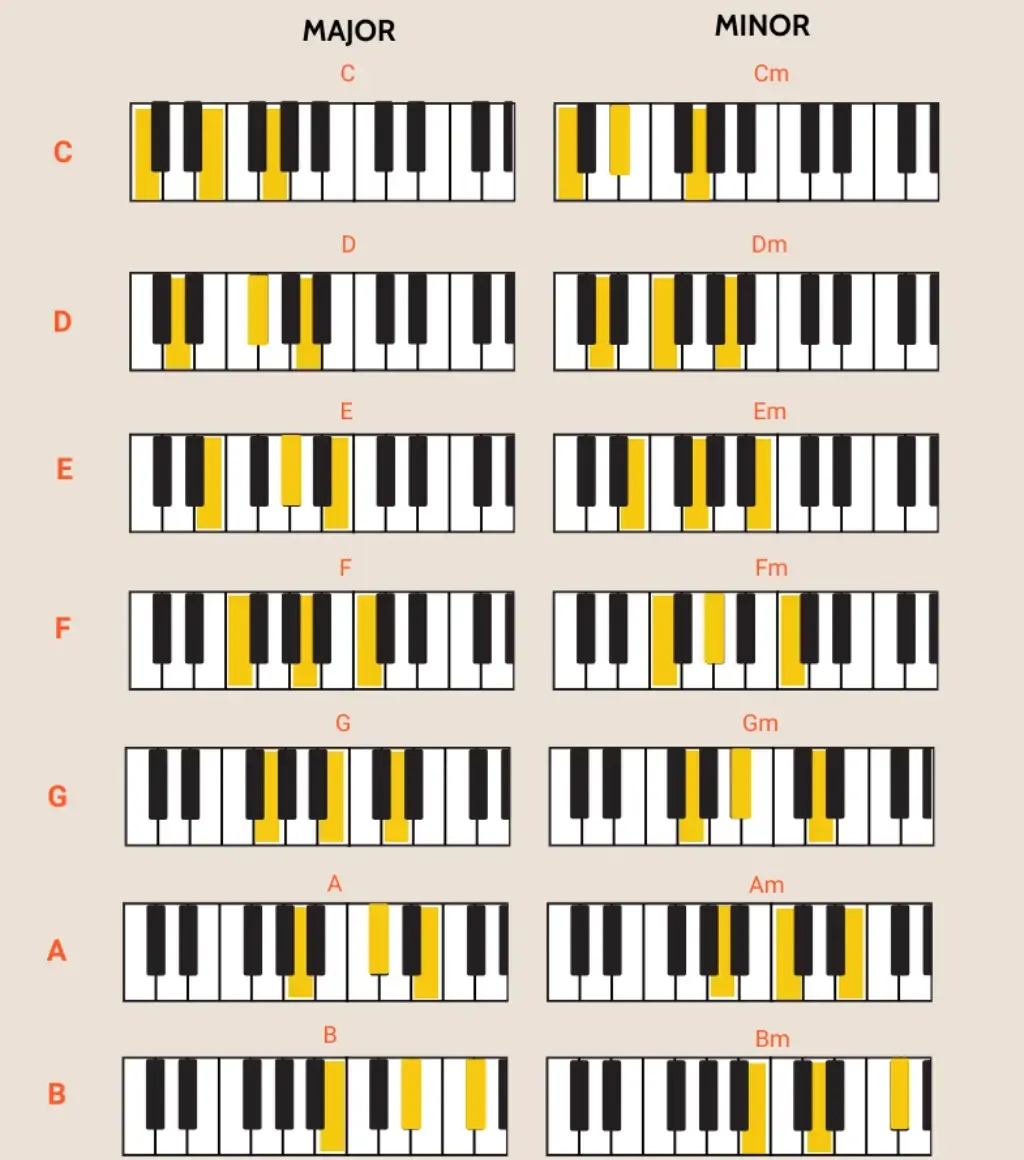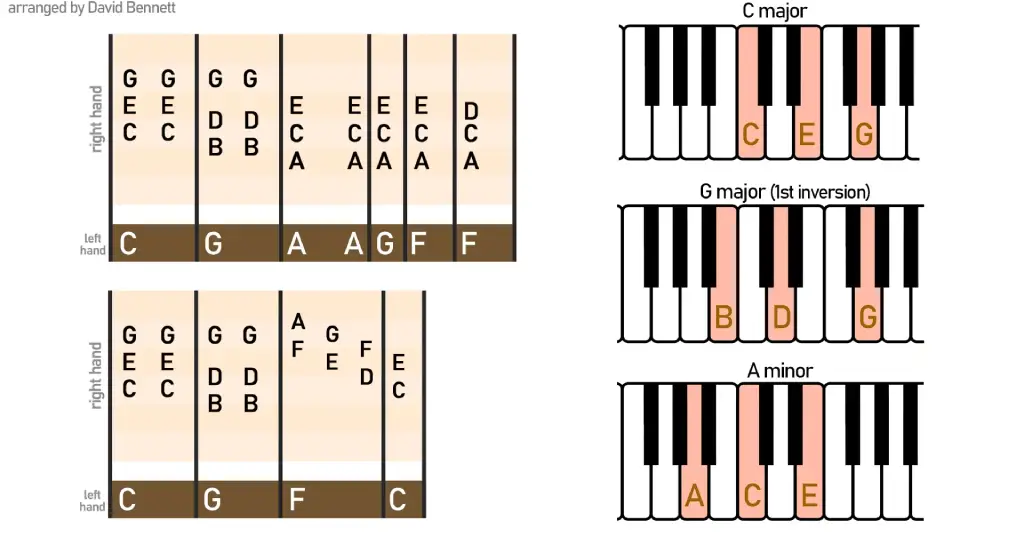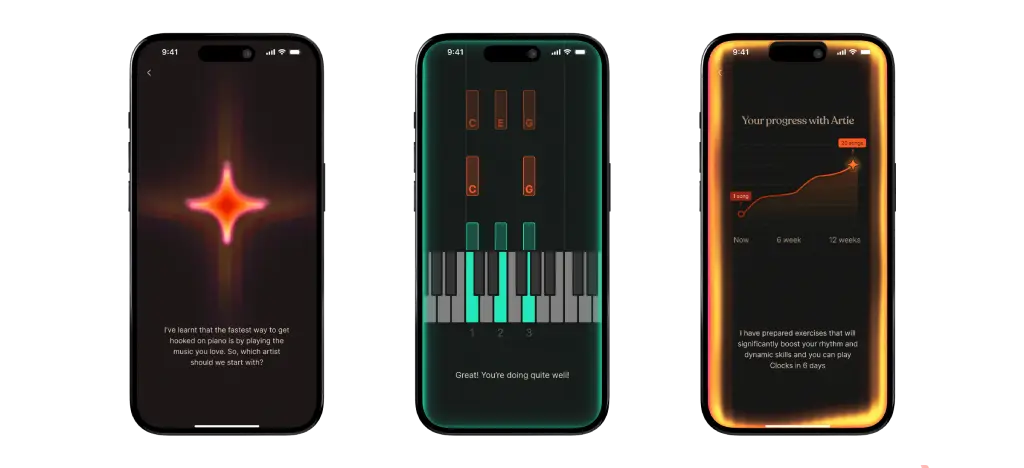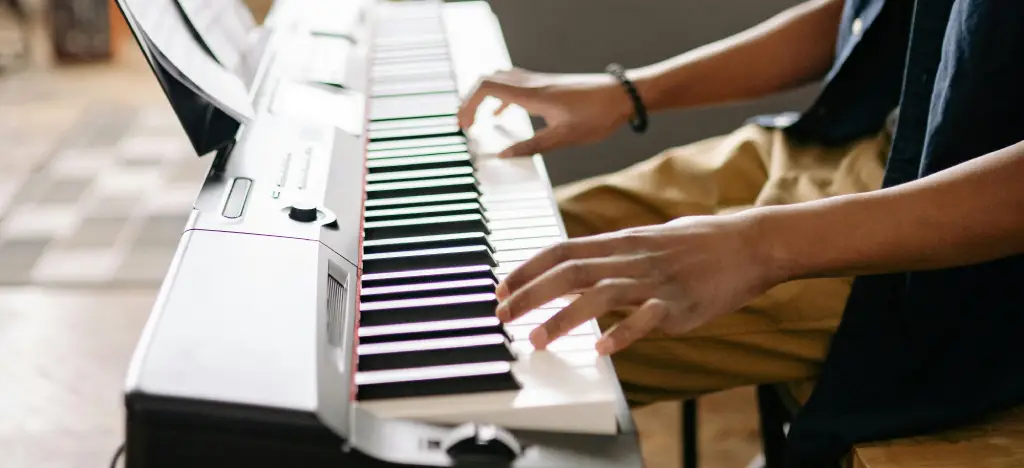Starting with simple, familiar songs is one of the best ways to fall in love with playing piano. It’s not just about learning notes — it’s about building confidence, developing real musical skills, and discovering the joy of playing something recognisable with your own two hands.
In this guide, we’ll show you how to pick the perfect first song, share 20 great options that are easy to learn, and walk you through a full step-by-step tutorial for Let It Be by The Beatles (with a free video lesson) — no sheet music required.
- Do you need to read sheet music to learn a piano song?
- Why learning a song on piano is perfect for beginners
- Choosing the perfect first song on piano
- 20 easy songs to learn on piano (with chords)
- Video tutorial: Learn 'Let It Be' on piano
- Step-by-step guide to playing 'Let it Be'
- Tips for learning your first song on piano
- Try our AI piano teacher & learn you first piano song for free
Do you need to read sheet music to learn a piano song?
Absolutely not!
When I started learning piano as a kid, my teacher insisted on traditional sheet music — and honestly, it nearly made me give up. The clefs, sharps, rests... it felt more like a maths lesson than music. What made it click for me was using piano letter notes and visual guides — tools that let me learn by playing, not just decoding symbols.
You’ll see exactly how that works in the Let It Be guide below.
💡 ARTMASTER TIP: Want to start playing with letter notes and visual guides instead of traditional notation? Check out Start playing piano: an easy guide for beginners — it breaks down everything you need to get started today.
Why learning a song on piano is perfect for beginners
You don’t have to start with scales or nursery rhymes to become a piano player. In fact, jumping straight into a song you love is one of the most effective and motivating ways to learn.
Here’s why it works so well:
You stay motivated – Playing something familiar is far more rewarding than dry exercises.
You build real skills – Most pop and rock songs are based on simple chord patterns you’ll use over and over again.
You feel progress quickly – Learning just one song helps you practise rhythm, hand coordination, dynamics and timing — all at once.
You learn musically, not mechanically – Songs are emotional, which means you naturally pay more attention to expression and phrasing — a skill even advanced players need.
💡 ARTMASTER TIP: Playing songs is more than just fun — it actually trains your musical brain. See what the science says in how learning music benefits the brain and body.
Choosing the perfect first song on piano
When choosing your first piano song, look for something that:
Has a clear, simple chord structure
Includes repetition so you don’t have to memorise too much
Feels personal or meaningful — because emotion fuels practice
Comes with a beginner-friendly video tutorial or guide
Our list below ticks all those boxes — from classics to modern hits — each chosen because it helps you build real skills without overwhelming you.
20 easy songs to learn on piano (with chords)
 These songs use simple chord progressions and patterns that repeat, so you can focus on getting comfortable with the keyboard, not lost in notation.
These songs use simple chord progressions and patterns that repeat, so you can focus on getting comfortable with the keyboard, not lost in notation.
1. "Let It Be" by The Beatles
C – G – Am – F : Timeless, emotional, and incredibly easy to learn — perfect for smooth chord transitions and practising dynamics.
2. "Your Song" by Elton John
C – Dm – Em – E : This iconic song introduces players to essential chord shapes and provides a great platform for exploring dynamics and phrasing.
3. "Clocks" by Coldplay
Eb – Bb – Fm – Ab : A perfect introduction to repeating patterns and left-hand/right-hand coordination. You’ll feel like a real player in no time.
4. "Lean On Me" by Bill Withers
C – F – G – Am : An uplifting, soulful tune built on straightforward progressions — great for working on rhythm and syncopation.
5. "My Future" by Billie Eilish
Gm – G# – G#m : Soft and moody — ideal for practising dynamic control and left-hand shapes in a slower tempo.
6. "In The End" by Linkin Park
Em – C – G – D : Modern, emotional and accessible. Great for working on rhythm, contrast and creativity with the pentatonic scale.
7. "All of Me" by John Legend
Em – C – G – D : Simple chords and expressive phrasing. Great for beginners ready to start exploring touch and dynamics.
8. "Someone Like You" by Adele
A – E – F#m – D : Perfect for learning broken chords and left-hand arpeggios with emotional flow.
9. "Stay With Me" by Sam Smith
Am – F – C – G : Uses classic pop progressions — great for steady rhythm and dynamic expression.
10. "Piano Man" by Billy Joel
C – G – Am – F – Dm : A bit more challenging, but an iconic piece for developing left-hand movement and storytelling at the keys.
11. Imagine – John Lennon
C – Cmaj7 – F : Simple but emotional — great for phrasing and pedal use.
12. Perfect – Ed Sheeran
G – Em – C – D : A beautiful ballad to practise consistent rhythm and hand coordination.
13. Hallelujah – Leonard Cohen
C – Am – F – G : Timeless and meditative — excellent for chord timing and emotion.
14. Let Her Go – Passenger
C – D – Em – G : Gentle, flowing and repetitive — perfect for finger independence.
15. Someone You Loved – Lewis Capaldi
C – G – Am – F : Simple chords, strong melody — great for emotional dynamics.
16. Counting Stars – OneRepublic
Am – C – G – F : Fun and rhythmic — good for switching between hands and exploring patterns.
17. Love Me Tender – Elvis Presley
D – A – G : Classic and slow-paced — excellent for learning chord changes.
18. A Thousand Years – Christina Perri
Bb – F – Gm – D# : A romantic favourite that reinforces timing and balance.
19. Let It Go – Idina Menzel (Frozen)
C – G – Am – F : Popular, repetitive, and great for children or families learning together.
20. Shallow – Lady Gaga & Bradley Cooper
Em – D – G – C : A modern favourite with a simple progression and lots of emotional range — perfect for beginners looking to play something current and expressive.
💡 ARTMASTER TIP: Want to understand the chords behind these songs? Explore our guide to piano chords, including simple keyboard diagrams. Learn more simple songs in our guide to 100+ songs you can play with just 4 chords
Video tutorial: Learn 'Let It Be' on piano
Learning this song (a favourite of my uncle), was what kept me motivated to keep playing. It’s got simple chords which are basically the same in the verse and chorus, and the contrast between the softer verses and fuller chorus makes it ideal for practising dynamics.
Take a look at David Bennett explaining how to play the chords to 'Let It Be' on piano from his Piano for Beginners course.
Step-by-step guide to playing 'Let it Be'
Step 1: Start with the right-hand chords
In this arrangement, your right hand will be mostly playing the full chords for the song. Here are the shapes to practice:
C major: C-E-G
G major (1st inversion): B-D-G
A minor: A-C-E
F major part: (see below)
Take your time practising each chord and focus on smooth transitions between them, as David explains in his video above. Here are the notes on his arrangement from the course:

Step 2: Add the left-hand bass notes
The left hand plays single bass notes that correspond to each chord:
C - G -A - F
Keep the bass notes steady as you add them to your practice.
Step 3: Combine both hands
Now, play the right-hand chords and left-hand bass notes together. Start slowly and focus on timing. This is where the song begins to come together.
Step 4: Add rhythm and dynamics
To make your playing more expressive:
Experiment with dynamics: play softly in the verses and louder in the chorus.
Add rhythmic variation: try holding the bass notes steady while playing the chords with a slight swing.
Step 5: Play the whole song
Once you’ve practised, bring it all together and play the full song with the vocal part. It doesn’t have to be perfect—what matters is enjoying it.
And when the broken hearted people living in the world agree
There will be an answer, let it be
For though they may be parted, there is still a chance that they will see
There will be an answer, let it be
Let it be, let it be, let it be, let it be
There will be an answer, let it be (x3)
And when the night is cloudy there is still a light that shines on me
Shinin' until tomorrow, let it be
I wake up to the sound of music, Mother Mary comes to me
Speaking words of wisdom, let it be
And let it be, let it be, let it be, let it be
Whisper words of wisdom, let it be (x2)💡 ARTMASTER TIP: Love this lesson? It’s part of David Bennett’s Piano for Beginners. It also covers Clocks, Lean On Me, and Imagine — all broken down step by step.
Tips for learning your first song on piano
No matter which song you choose, here are a few practice tips that you can apply to any track.
1. Start with the right hand
Play the melody slowly. Focus on accuracy rather than speed.
Use finger numbers to develop muscle memory.
2. Add the left hand gradually
Practice simple chords or bass notes in isolation before combining with the melody.
Start hands together only when both are steady individually.
3. Use a metronome
A metronome is a really useful and simple tool to help maintain rhythm.
4. Break it down
Divide the song into sections (intro, chorus, bridge). Learn and practice each part before putting them together.
5. Refine and add emotion
Focus on dynamics by playing louder in dramatic sections and softer during introspective parts. Experiment with phrasing to make the music your own.
6. Celebrate small wins
Record yourself playing and watch your progress. Play it for friends or family for encouragement.
💡 ARTMASTER TIP: For more practice tips, check out our guide — The art of effective music practice
Try our AI piano teacher & learn you first piano song for free
Learning your first song is a milestone — it’s where music stops being abstract and starts feeling real. With David Bennett’s step-by-step approach in our Piano for Beginners course, you’ll build confidence through songs that sound good from the very first notes.
Start your 7-day free trial and play your first song today
But what if you had someone listening as you play — giving you real-time tips on your timing, pressure, and dynamics?
That’s where Artie comes in.
Artie is our new AI piano teacher — built especially for beginners. He listens as you play and gives you helpful, encouraging feedback on things like:
Are you pressing too hard?
Is your rhythm steady?
Are your hands balanced?
You’ll get guidance on timing, touch, and expression — exactly the kind of insight that helps beginners grow faster, without frustration.
And the best part? You can help shape him.
Join the Artie waitlist here


